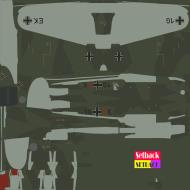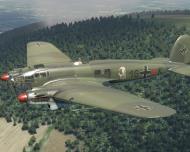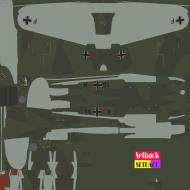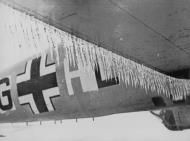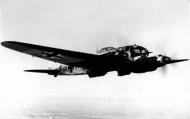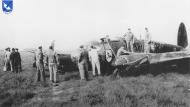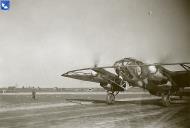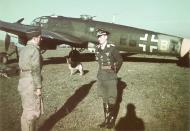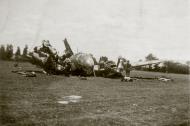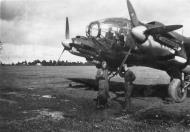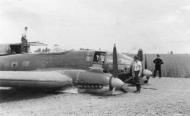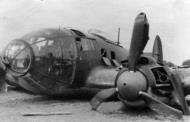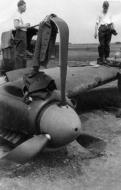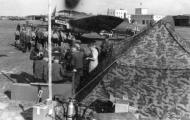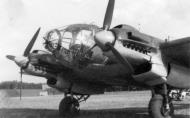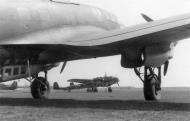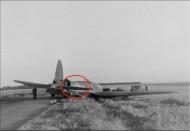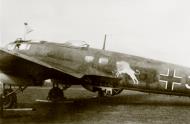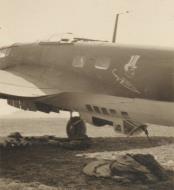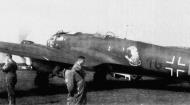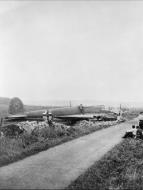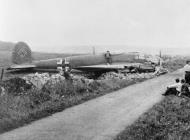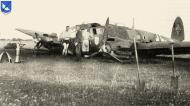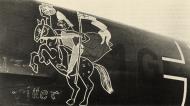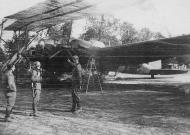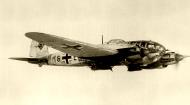Heinkel He 111H KG27 (1G+) Eastern Front
Heinkel He 111 H-5 1./KG27 WNr 3681 crash landing France
Photo 01: Heinkel He 111H5 1./KG27 WNr 3681 crash landing France Apr 09 1941. The pilot Lt Hubert Tscheplak was wounded and the Beobachter Gerhard Nicklaus killed. Both the Bordfunker Uffz Weber and Bordschutze Uffz Faust remainded unhurt. Although wounded Lt Hubert Tscheplak flew back to friendly territory and belly landed the Heinkel.
Heinkel He 111 P-2 Stab I./KG27 (1G+BB) flown by Paul Hollinde Gablingen 1939-40
Heinkel He 111 P-2 Stab I./KG27 (1G+BB) flown by Paul Hollinde Gablingen autumn/winter 1939-40. The artwork depicts Frederick the Great, also known as Old Fritz. It is also a reference to group commander oberstlt. Fritz Graumintz, who ordered the artwork painted on 1G+BB when the aircraft was based at Hannover Langerhagen. It was later flown by Paul Hollinde at Gablingen near Augsberg. Gablingen is a municipality in the district of Augsburg in Bavaria in Germany. References for details and colour scheme - Kagero publishing.
1. Staffel I. Gruppe Kampfgeschwader 27 - 1./KG27Heinkel He 111H 1./KG27 (1G+AH) Norway 1939-40
Heinkel He 111 P-2 1./KG27 (1G+KH) 'Buffalo' Langendiebach Hesse Sep 1939
History of the Airfield: Hanau Army Airfield is a former military airfield, located 5.2 km (3.2 mi) north-northeast of Hanau in Hesse, Germany. Erlensee is a municipality in the Main-Kinzig district, in Hesse, Germany. It is situated on the river Kinzig, 5 km northeast of Hanau. It was formed in 1970 by the merger, in 1970, of the towns of Langendiebach and Rückingen. The name deduces from the abundant alders at the lakes (Erlen=alders, See=lake) in this area.
Ground was broken for the construction of the Langendiebach Airfield, or Fliegerhorst Langendiebach as it was then known, in the summer of 1936, after a Junkers Ju 52 on maneuvers made an emergency landing in the meadows behind Reusserhof. Although it was originally intended that there should be three phases of construction, only the first phase of construction was completed, due to the outbreak of World War II. The official opening of the Fliegerhorst on 19 March 1939 was marked by a large celebration, involving a parade from the center of Erlensee to the front gate, and a Volksfest of 25,000 German civilians, who were treated to an air show.
In 1940, Langendiebach became the site of a glider school (Flughafen-Bereichs-Kommando 3/XII), the graduates of which went on to participate in, among other operations, the invasion of the Soviet Union ("Operation Barbarossa"). In addition to gliders, there were various experimental aviation units at Langendiebach, including a high-altitude fighter squadron. From the middle of 1944 until the Americans succeeded in crossing the Rhine, two successive groups of Junkers Ju 88 Nightfighters, the I/NJG 4 then III/NJG4, were stationed at Langendiebach. Once the Americans had crossed the Rhine River, these elements of the Nachtjagdgeschwader 4 (NJG 4) were withdrawn to North Eastern Germany.
The three most destructive bombing attacks on Fliegerhorst Langendiebach occurred on 9 September 1944, 10 November 1944 and 24 December 1944. The bombing raid carried out on 10 November involved 229 B-24 Liberators, which dropped a total of 431.5 tons of bombs. This bombing was conducted in the light of recent intelligence, which revealed that the Langendiebach runway had recently been extended by some 300 meters to accommodate three Messerschmitt Me 262 jet fighters of Kampfgeschwader 55 (KG 55) "Greif", however the unit never received any of the jet fighters.
In order to divert allied attacks away from Langendiebach, the Germans emplaced decoy airfields, consisting of wooden mock-ups of aircraft and of airfield facilities, in the vicinity of Mittelbuchen, Kilianstädten, and Roßdorf. These succeeded in leading low-flying aircraft astray on many occasions, but could not prevent the comprehensive destruction inflicted upon Langendiebach by war's end. The buildings and facilities of the air base were assessed as 20% destroyed, and the severely pockmarked runway as totally unserviceable. Furthermore, the woods were bombed from Bärensee to Rückingen, in order to eliminate the camouflaged aircraft in parking spots concealed by woods. Present-day B40, which could be used as an auxiliary runway, was also bombed.
Fliegerhorst Langendiebach's facilities and airfield were totally unserviceable when the Americans occupied the area in April 1945, and the airfield was converted by IX Engineering Command, Ninth Air Force into an Army Air Forces advanced Landing Ground, designated Y-91. Air Force units used the airfield as a casualty evacuation and combat resupply airfield by the IX Air Service Command. After the German Capitulation on 8 May, it was re-designated as "Army Air Forces Station Hanau/Langendiebach". Army Air Forces units moved out in August, and the facility was taken over by United States Army.
Hanau became a major United States Army aviation facility during the Cold War, also known as Fliegerhorst Army Airfield. In 1952, several construction projects were undertaken to give the airfield back its character as a military facility. It was during this period that the large ammunition bunkers west of the airfield were built. From 1957 to 1960, Hangars 1302, 1303 and 1304, and the control tower were converted and refitted to accommodate helicopter aviation. Due to the troop reductions pursuant to the Conventional Forces in Europe Treaty and the Treaty of Vienna, many battalions have been removed from Fliegerhorst since 1991. Fliegerhorst still stands as one of the most important US Army Aviation Airfields in Europe.
Langendiebach Map
Heinkel He 111 P-2 2./KG27 coded (1G+EK) named 'Jester' flown by Scholz based Neukuhren, East Prussia during the Invasion of Poland 1939
Heinkel He 111 H-6 2./KG27 coded 1G+HK and based in Russia 1943
3. Staffel I. Gruppe Kampfgeschwader 27 - 3./KG27
Heinkel He 111H 3./KG27 (1G+BL) crash-landed back in France after being attacked by British fighters during the Battle of Britain. It carries the badge of 1./KG27
Heinkel He 111 P-2 3./KG27 (1G+HL) named 'Luftikus' and based Neukuhren, East Prussia, September 1939
When the region was part of Germany the town was known as Neukuhren. It was annexed by the Soviet Union in 1945 upon the end of World War II. Now known as Pionersky is a town in Kaliningrad Oblast, Russia, located along the Baltic Sea on the Sambian Peninsula, between Zelenogradsk and Svetlogorsk.
5. Staffel II. Gruppe Kampfgeschwader 27 - 5./KG27
Heinkel He 111P 5./KG27 (1G+FN) 'Witch' WNr 1417 Seerappen East Prussia Sep 1939
History of the Airfield: Lyublino (German: Seerappen; Lithuanian: Serupänai, Serapai) is a settlement under jurisdiction of the town of Svetly in Kaliningrad Oblast, Russia. Before 1945, it was a German village of Seerappen in Kreis Fischhausen, East Prussia. It was known for being the site of an airship base, then a Luftwaffe airbase, and a concentration camp.
Lyublino airfield (also known as Luftschiffhafen Seerappen or Fliegerhorst Seerappen) is an abandoned airfield 14 kilometers west of Kaliningrad, Russia. It was located just north of the Kãnigsbergen-Pillau railroad. The airfield was built in 1916 by the Dortmund company Aug. Klãnne, in what was then East Prussia, Germany. It consisted of a double airship hangar and a flying field. At the time it boasted one of the largest sites for the construction of airships. In 1917 the German high command decided to withdraw all airships. Seerappen was used for the storage of LZ 120 and LZ 30. LZ 120 was taken from storage in 1920, when it was prepared to be delivered to Italy as a war reparation.
Its hangar is believed to have been demolished before 1929.
In the 1930s the field was rebuilt into a Fliegerhorst by the Nazis. It became known as Fliegerhorst Seerappen. The fliegerhorst featured 1200x800m flying field. Located at the airfield was Fliegerfuhrerschule (FFS) E 'Seerappen'. In March 1941 it was was the formation location of FFS A/B 5. The airfield was also home to II./Zerstãrergeschwader (ZG) 76, Stab/Kampfgeschwader 1 and Blindfliegschule B38.
Seerappen was taken by the Red Army on 30 January 1945, but they lost it 3 weeks later. It was retaken after heavy fighting in early April 1945.
After the fall of Kãnigsbergen the name of the city was Russified to Kyonigsberg, and the airfield to Lyublino). Around 1950 Kyonigsberg became Kaliningrad and of strategic importance to the Russians. As a result Lyublino became an army garrisson and barracks. Some of the Luftwaffe buildings still exist. According to Russian websites the site is now abandoned.
Kaliningrad Map
Heinkel He 111H 5./KG27 (1G+KN) Russia 1943
6. Staffel II. Gruppe Kampfgeschwader 27 - 6./KG27
Heinkel He 111H 6./KG27 (1G+HP) Russia 1943
Heinkel He 111P 6./KG27 (1G+JP) de Bourges France 1940
7. Staffel III. Gruppe Kampfgeschwader 27 - 7./KG27
Heinkel He 111H 7./KG27 (1G+ER) Russia 1941 01
After continuous operations, the temporary white finish applied to bombers operating during the harsh Russian winter began to wear off giving them a very patchy appearance. Where time and operational conditions allowed it, this paint was re-applied, but this often proved far from easy in freezing temperatures. This He 111H of 7./KG27 has the whole of its code 1G+ER, painted in black. At this time, November 1941, III./KG27 was based at Millerovo and commanded by Hptm. Hans-Henning Freiherr von Beust. In January von Beust took over as Kommodore of the Geschwader.
Heinkel He 111P 8./KG27 (1G+HS) Wunstorf France 1940
9. Staffel III. Gruppe Kampfgeschwader 27 - 9./KG27
Heinkel He 111H 9./KG27 (1G+BT) Stfkpt Walter Grasemann 1942
Werner Molders was killed as a passenger in this He 111 1G+BT flown by Kolbe which crashed
20. Staffel V. Gruppe Kampfgeschwader 27 - V./KG27
Heinkel He 111 H-11 20./KG27 (1G+BI) Russia 1942
Paul Hollinde
Units: Stab I./KG27
Awards: Bomber Operational Clasp
Known Aircraft:
Remarks: Led attack on Aircraft factory 'Filton' 7 March 1941.
Fritz Jurges - Fritz Jürges
Units: 1/KG-55
Awards: Wound Badge, Bomber Operational Clasp
Known Aircraft: He 111P WNr 6305 'G1+BH' (lost)
Remarks: POW after making a force landing at Westfield Farm, Studland, near Swanage, Dorset at 12:10 hours. During his mission over Filton, he was attacked by a Hurricane of RAF No.238 Sq, piloted by P/O J.S. Wigglesworth and a Spitfire of RAF No.609 Sq, piloted by P/O J. Curchin. Remaining crew (all POW): Hptm Karl Kãthke, Observer; Gefr Rudolf Weisbach, R/O; Flg Otto Müller, Gunner and Uffz Josef Altrichter, Mech. Altrichter died later that same day. Source: Bristol Past, John Penny.
Lt Scholz
Units: Scholz
Awards: Bomber Operational Clasp
Known Aircraft: Heinkel He 111 P-2 2./KG27 coded (1G+EK) named 'Jester'
Remarks: ?
Fw W. Biskupski
Units: 9/KG-27
Awards: Wound Badge, Bomber Operational Clasp
Known Aircraft: He 111P '1G+EK' (lost)
Remarks: WIA/POW 14 May, 1940 and crash landing his He 111 in the Brussels area. Source: A. Rosseels.
Hans Joachim Schmidt
Units: 2/KG-27
Awards: Bomber Operational Clasp
Known Aircraft: He 111 H-20 '1G+BL' (lost 3 July 1944)
Remarks: MIA 3 July, 1944 after being hit by anti-aircraft fire, crashing near Neu Sandez Poland. Source: D. Stankey.
Alfred Heinzl
Units: 3/KG-27
Awards: Bomber Operational Clasp
Known Aircraft: He 111H WNr 3664 '1G+HL' (lost)
Remarks: POW in 1941 after aerial combat with fighters and making a force landing by Wexford Ireland. Remaining crew: Fw Arthur Voigt POW, Observer; Fw Rudolf Hengst POW, R/O; Uffz Gerd Reiter KIA, Mechanic and Gefr Max Galler POW, Gunner. All were interned at Kildare Co. Ireland. Jager Blatt 4/2004.
Walter Grasemann
Units: Stfkpt 9/KG-27, Erg.KG(J), I/EKG(J)
Awards: RK(10/9/43), DK-G(3/19/42), EK 1 & 2, Wound Badge(7/8/43), Bomber Operational Clasp
Known Aircraft: He 111H-16 WNr 160927 (lost 7/43)
Remarks: WIA shot down with wounds by flak. DK-G Awards List
Kolbe
Units: Former Legion Condor pilot, 9/KG-27
Awards: Spanish Cross, Bomber Operational Clasp
Known Aircraft: He 111 '1G+BT' (lost )
Remarks: He was piloting the aircraft in which he and Mãlders were killed in the suburb of Schãngarten, near Breslau, on , going to Udet's funeral. The cause was bad weather and engine failure on his third landing attempt. His R/O, Ofw Arthur Tenz, was one of two of the five occupants to survive the crash. The other survivor was Mãlder's Adjutant Major Wenzel.
Heinkel He 111 Bibliography: +
- Andersson, Lennart (2008), A History of Chinese Aviation: Encyclopedia of Aircraft and Aviation in China to 1949, Taipei, Republic of China: AHS of ROC, ISBN 978-957-28533-3-7
- Bergström, Christer. Bagration to Berlin - The Final Air Battle in the East: 1944-1945. London: Chevron/Ian Allan, 2008. ISBN 978-1-903223-91-8.
- Bergstrom, Christer. Barbarossa - The Air Battle: July December 1941. London: Chevron/Ian Allan, 2007. ISBN 978-1-85780-270-2.
- Bergström, Christer. Kursk - The Air Battle: July 1943. London: Chevron/Ian Allan, 2007. ISBN 978-1-903223-88-8.
- Bergström, Christer. Stalingrad - The Air Battle: 1942 through January 1943. London: Chevron Publishing Limited, 2007. ISBN 978-1-85780-276-4.
- Bergström, Christer, Andrey Dikov and Vladimir Antipov. Black Cross Red Star: Air War Over the Eastern Front: Everything For Stalingrad, Volume 3. London: Eagle Editions, 2006. ISBN 978-0-9761034-4-8.
- Bridgeman, Leonard (1946), The Heinkel He 111 H, Jane's Fighting Aircraft of World War II, London: Studio, ISBN 1-85170-493-0
- The Classic Heinkel:Part Two - From First to Second Generation. Air International, September 1987, pp. 128-136. Bromley, UK: Fine Scroll. ISSN 0306-5634.
- Cruz, Gonzala Avila. "Pegqenos and Grandes: Earlier Heinkel He 111s in Spanish Service". Air Enthusiast, No. 77, September/October 1998, pp. 29-35. ISSN 0143-5450.
- de Zeng, H.L., D.G. Stanket and E.J. Creek. Bomber Units of the Luftwaffe 1933-1945: A Reference Source, Volume 1. London: Ian Allan Publishing, 2007. ISBN 978-1-85780-279-5.
- de Zeng, H.L., D.G. Stanket and E.J. Creek. Bomber Units of the Luftwaffe 1933-1945: A Reference Source, Volume 2. London: Ian Allan Publishing, 2007. ISBN 978-1-903223-87-1.
- Donald, David (1998). An Industry of Prototypes: Heinkel He 119. Wings of Fame. 12. London/Westport, Connecticut: Aerospace Publishing. pp. 30-35. ISBN 1-86184-021-7.
- Dressel, Joachim and Manfred Griehl. Bombers of the Luftwaffe. London: DAG Publications, 1994. ISBN 1-85409-140-9.
- Griehl, Manfred (2006). Heinkel He 111: The Early variants A-G and J of the Standard Bomber Aircraft of the Luftwaffe in World War II. World War II Combat Aircraft Photo Archive ADC 004. Part 1. Ravensburg, Germany: Air Doc, Laub GmbH. ISBN 3-935687-43-5.
- Griehl, Manfred (2008) [1994]. Heinkel He 111: P and Early H variants of the Standard Bomber Aircraft of the Luftwaffe in World War II. World War II Combat Aircraft Photo Archive. Part 2. Ravensburg, Germany: Air Doc, Laub GmbH. ISBN 978-3-935687-46-1. ADC 007.
- Hayward, Joel S.A. Stopped at Stalingrad: The Luftwaffe and Hitler's Defeat in the East, 1942-1943 (Modern War Studies). Lawrence, Kansas: University Press of Kansas, 1998 (hardcover, ISBN 0-7006-0876-1); 2001 (paperback, ISBN 0-7006-1146-0).
- Heinkel He 111(film). Network Projects Production, 1993.
- Hooton, E.R. Luftwaffe at War, Blitzkrieg in the West: Volume 2. London: Chevron/Ian Allan, 2007. ISBN 978-1-85780-272-6.
- Hooton, E.R. Luftwaffe at War, Gathering Storm 1933-39: Volume 1. London: Chevron/Ian Allan, 2007. ISBN 978-1-903223-71-0.
- Joachim Dressel and Manfred Griehl. Bombers of the Luftwaffe. DAG Publications. 1994. ISBN 1-85409-140-9
- Janowicz, Krzysztof (2004), Heinkel He 111: Volume 1, Lublin, Poland: Kagero, ISBN 978-83-89088-26-0
- Kober, Franz. Heinkel He 111 Over all Fronts. Atglen, Pennsylvania: Schiffer Military History. 1992. ISBN 978-0-88740-313-2.
- Mackay, Ron (2003), Heinkel He 111, Crowood Aviation Series, Ramsbury, Marlborough, Wiltshire, UK: Crowood Press, ISBN 1-86126-576-X
- Munson, Kenneth. Fighters and Bombers of World War II. London: Peerage Books, 1983. ISBN 0-907408-37-0.
- Nowarra, Heinz J (1990), The Flying Pencil, Atglen, Pennsylvania: Schiffer Publishing, ISBN 0-88740-236-4
- Nowarra, Heinz J (1980), Heinkel He 111: A Documentary History, London: Jane's Publishing, ISBN 0-7106-0046-1
- Punka, György (2002), Heinkel He 111 in action, Carrolton, Texas: Squadron/Signal Publications Inc., ISBN 0-89747-446-5
- Regnat, Karl-Heinz (2004), Black Cross Volume 4: Heinkel He 111, Hersham, Surrey, UK: Midland Publishers, ISBN 978-1-85780-184-2
- Rise and Fall of the German Air Force: 1933 - 1945 (Public Record Office War Histories). London: Public Records Office, 2000. ISBN 978-1-905615-30-8.
- Smith, J. Richard and Anthony L. Kay. German Aircraft of the Second World War. Annapolis, Maryland: US Naval Institute Press, 2002. ISBN 1-55750-010-X.
- Warsitz, Lutz (2009), The First Jet Pilot: The Story of German Test Pilot Erich Warsitz, London: Pen and Sword Books Ltd., ISBN 978-1-84415-818-8 (Including early developments and test flights of the Heinkel He 111 fitted with rocket boosters)
- Wagner, Ray and Nowarra, Heinz. German Combat Planes: A Comprehensive Survey and History of the Development of German Military Aircraft from 1914 to 1945.New York City, Doubleday. ISBN
Magazines: +
- Airfix Magazines (English) - http://www.airfix.com/
- Avions (French) - http://www.aerostories.org/~aerobiblio/rubrique10.html
- EDUARD - https://www.eduard.com/
- EDUARD - Are in my opinion are what modelers are looking for loads of pictures and diagrams and have become a leading historical information source. *****
- FlyPast (English) - http://www.flypast.com/
- Flugzeug Publikations GmbH (German) - http://vdmedien.com/flugzeug-publikations-gmbh-hersteller_verlag-vdm-heinz-nickel-33.html
- Flugzeug Classic (German) - http://www.flugzeugclassic.de/
- Klassiker (German) - http://shop.flugrevue.de/abo/klassiker-der-luftfahrt
- Luftwaffe IM Focus (German) - https://www.luftfahrtverlag-start.de/
- Embleme der Luftwaffe Band-1 (German) - https://www.luftfahrtverlag-start.de/
- Le Fana de L'Aviation (French) - http://boutique.editions-lariviere.fr/site/abonnement-le-fana-de-l-aviation-626-4-6.html
- Le Fana de L'Aviation (French) - http://www.pdfmagazines.org/tags/Le+Fana+De+L+Aviation/
- Osprey (English) - http://www.ospreypublishing.com/
- model airplane international magazine - https://adhpublishing.com/shop/store/magazine-backissues/model-airplane-international-backissues/
- Revi Magazines (Czech) - http://www.revi.cz/
Web References: +
- eBay - https://picclick.de/ or https://www.ebay.com
- Pinterest - https://www.pinterest.com
- Nordic Aviation in World War 2: http://www.rafandluftwaffe.info/
- Photographic Site Airliners.net: http://www.airliners.net/
- Wikipedia, the free encyclopedia: http://en.wikipedia.org/wiki/Heinkel_He_111
- Wikipedia, the free encyclopedia: https://en.wikipedia.org/wiki/Heinkel_He_111_operational_history
- Wikipedia, the free encyclopedia: http://en.wikipedia.org/wiki/Heinkel_He_115
- http://www.preservedaxisaircraft.com/Luftwaffe/heinkel/he111.htm List of He 111 survivors
- http://www.flysamlingen.museum.no/index.php/om_flysamlingen/utstillinger Museum with He 111P in Norway
- http://ju88.net/ Museum volunteers site, click on: OTHER - OTHER PROJECTS - 111P
- http://www.preservedaxisaircraft.com/Luftwaffe/heinkel/he111.htm List of He 111 survivors
- http://ktsorens.tihlde.org/flyvrak/buvikvoll.html An article on a He 111 wreck site in Norway
- http://www.battleofbritain.net/0017.html BattleOfBritain.Net He 111
 Editor for Asisbiz: Matthew Laird Acred
Editor for Asisbiz: Matthew Laird Acred
If you love our website please subscribe to our YouTube video channel
Please donate so we can make this site even better !!






